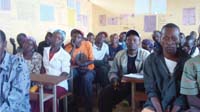14.1.1 Methods of organising the community
There are different methods that you might be able to use in order to organise the community in which you work. You may be able to organise the community according to:
- Their place of work
- Common characteristics of the people
- The issue addressed
- Location or geography.
Look carefully at the list above. It shows some of the methods that you may be able to use to organise groups in your community. Think of examples from your own work for each item, where the community has been organised in this way.
Here are some examples. You may have thought of others as well. You can organise the community according to the following:
- Work place – for example; farmers’ association, teachers, or a student group.
- Common individual characteristics — for example, gender, or parents with young children.
- Issue you are dealing with — for instance, anti-AIDS club, women’s association, women’s idirs.
- Geography or location — you can organise people according to a specific part of a village.
According to your own interests and skills — and the needs within your community — you can organise the community to involve them in many different types of health education activities (Figure 14.2). It is best to begin with those people or groups who are already interested in addressing the community problem. In some situations, the community members may already be organised for certain purposes. In this case, you can assess the background and interest of the organised groups and work with them. So, you may not need to organise new groups if there are community groups which are already organised. Each community is different, and a variety of problems may occur. It is never easy to organise the community, and it may be possible for you to work with community leaders. Community leaders are often good organisers, and people tend to follow their example.

Look below at the characteristics of community leaders. Then think of examples from your own work where community leaders have played an important role.
- Community leaders can facilitate, and make easier, the organising process, — you may be able to identify community leaders and work with them.
- If possible, the leader should be someone with good leadership skills, as well as knowledge of the health problem, and of the community.
What sorts of features came into your mind as you thought about community leaders? Community leaders are usually able to ‘speak up’ for other people. They usually know a great deal of what is going on in their community. They also command the respect of the community. In this answer, we have highlighted some of the things which make community leaders such valuable allies.
14.1 Implementation
